|
Monday, July 28, 2008
Progress Notes
A couple of weeks ago Jim Pryor donated to the museum a broad axe used by Elmer Flaugher which Elmer used to hew out railroad ties many years ago to sell to the railroad industry. Here is a photo of Jim with the axe (photo 01)
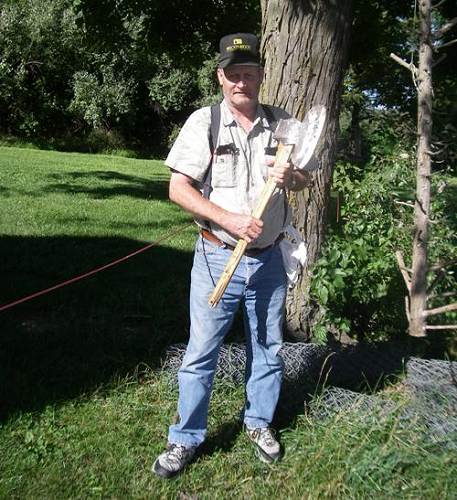
01 Jim Pryor with Axe used by Elmer Flaugher
and here are some photos of Elmer using the axe in a demonstration for the Bicentennial Celebration in Tuscumbia in 1976 (photos 02, 03 and 04).
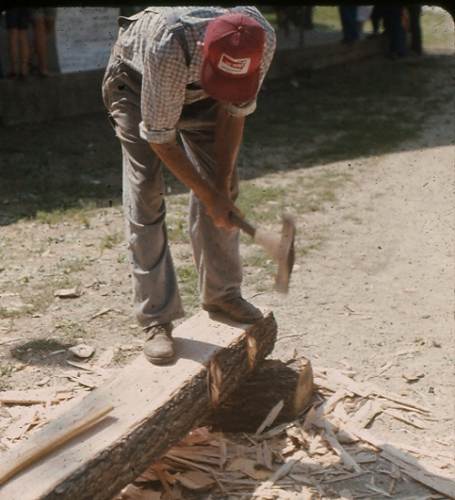
02 Elmer Flaugher
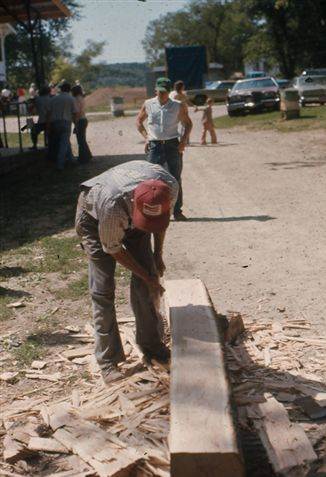
03 Elmer Flaugher
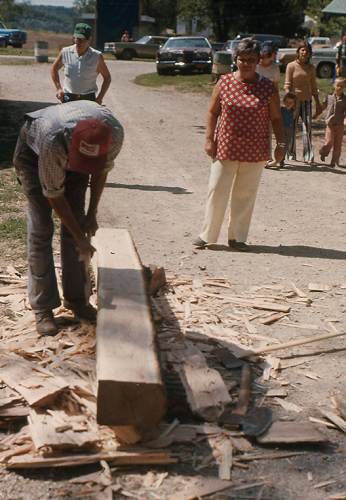
04 Elmer Flaugher
Notice that Elmer is using more than just a broad axe to whack into shape the tie. Also, in photo 2 is pictured a measuring rod on top of the tie. The chips on the ground are called “juggles.” Later in this narrative more will be presented about the tools and unusual names and terms used by the tie whackers.
Besides Elmer, many other farmers in Miller County made ties during the latter part of the 19th and early 20th centuries including Clifton Workman (photo 05) and Arthur Edwards (photo 06).
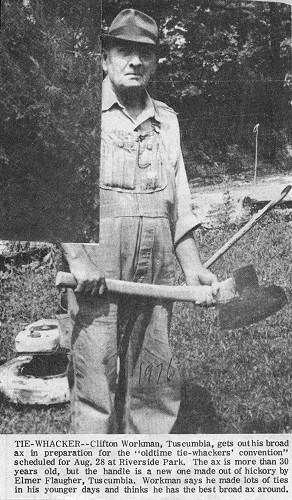
05 Clifton Workman
Click image for larger view
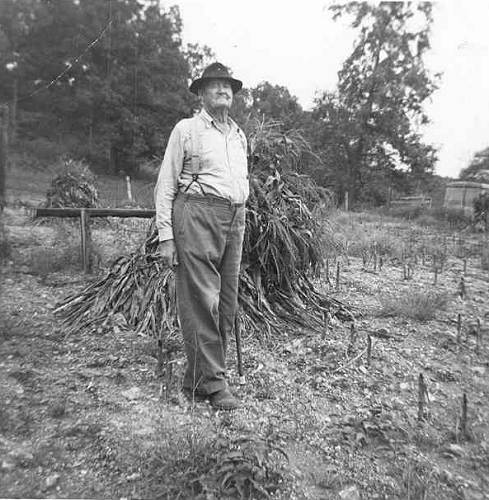
06 Arthur Edwards
One well known tie whacker was Clarence Barton of St. Elizabeth. Peggy Hake has written a summary of her interview with him several years ago which you can read on our own web site at:
http://www.millercountymuseum.org/commerce/tiehacking.html
After being made the ties had to be transported to a place of sale. For those tie whackers who were not close to a river or stream to float the ties downriver to a receiving area such as Bagnell, the ties had to be transported by a team of horses and wagon.
By far, most ties in this area were floated downstream to Bagnell for receipt by the Missouri Pacific Railroad. The R.S. Harvey store in Eldon received many ties at Bagnell. Here is a photo of a young Bill Harvey, grandson of R.S. Harvey, holding a tie marker which the store used to identify those ties it owned and were reselling to the railroad company (photo 07).

07 Tie Marker, Bill Harvey
Click image for larger view
And here are a number of photos depicting scenes of unloaded ties at the landing area near the railroad tracks in Bagnell (photos 08, 09, 10, 11 and 12).
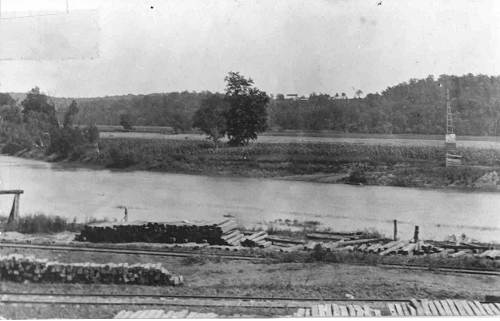
08 Bagnell Tie Yard
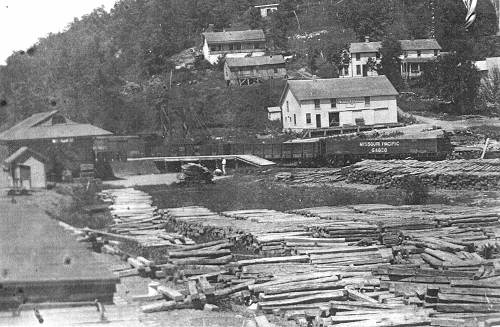
09 Bagnell Tie Yard
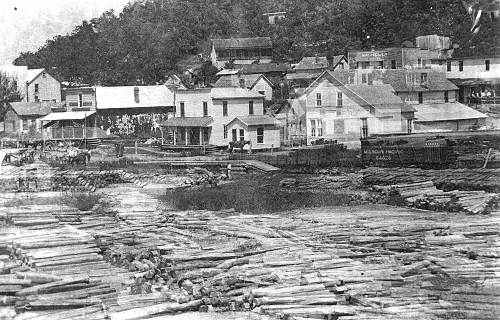
10 Bagnell Tie Yard
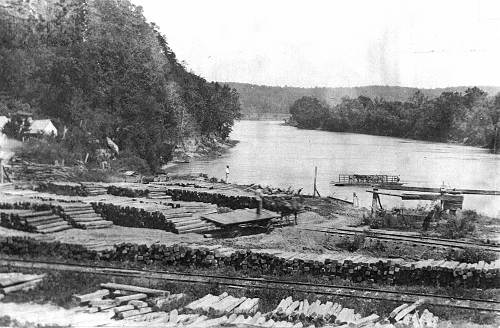
11 Bagnell Tie Yard
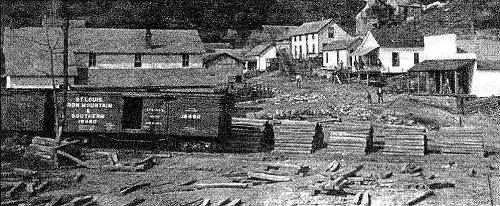
12 Bagnell Tie Yard
You can read more about Old Bagnell on our web site at:
http://www.millercountymuseum.org/communities/bagnell.html
For those farmers who lived near a stream which emptied into the Osage, the ties could be bundled together and worked their way down the stream to its confluence with the Osage. Otherwise, the ties were dragged by horse to the river bank. At the river bank the single rafts were combined into larger units of possibly 20,000 ties. More men were needed on these rafts and an oar on the bow aided in control.
Many ties were made far from the river, a road, or even a trail. These were “snaked” out by hitching a horse to the tie. When dragged to the river bank or a road accessible by wagon they were piled to await the buyer, brander and rafter.
If the ties were to be delivered to the buyer by the river, a new force took over, the rafter. Nailing ties into long sections held by binders of white oak saplings, the rafters worked in water waist deep until the ties were bound into the long strips forming the raft.
Two men usually manned a raft on the smaller streams, one at each end, guiding, snubbing and maneuvering around river bends, paddling through placid eddies and slowing the progress through swift shoals by dragging the “snub pole” along the bed of the stream. Occasionally disaster came and ties piled up in a tangled heap, breaking the binders and even losing part of the raft. When night overtook them, the raft was tied along the bank near enough to a farm house for the men to find food and shelter.
At or near the mouth of the creek as it entered the Osage, the rafts were safely anchored to trees along the bank until enough arrived to combine into large sections for rafts to float down the Osage to Bagnell where they were taken from the water, loaded upon flat cars and taken wherever needed for construction of railroad beds.
The trip down the Osage was longer, the current slower, and more men needed for each raft. Meals were cooked upon the raft by building a fireplace of mud and stones above the level of the raft. The men slept in shifts. For such strenuous effort, men were paid $1.50 per day with meals.
Lynn Barnickol wrote a very interesting article in the Missouri Conservationist about tie making giving some details about just how they were made accompanied by some diagrams:
Missouri Conservationist
October 1996
Lynn Barnickol
A distant steam whistle, a piercing headlight, billowing clouds of smoke and the hiss of steam as cylinders stroke massive drive wheels were the sights and sounds of an approaching steam powered railroad locomotive. The sleepers rested quietly below, supporting the steel rails.
An idea was born in 1832 when Robert Stevens, the president and chief engineer of the Camden and Amboy Railroad of New Jersey, ran out of stone blocks on which to mount the rails. As a substitute material, ties were hand hewn from logs cut from nearby forests. Later, it was noticed that the wood ties provided a smoother ride and wood has now been used for ties for over 160 years.
From the small narrow gauge engines that pulled logging and mining cars to the giant steamers built to pull mile long freights, railroads ran on steel rails. Wood rail road ties, called sleepers, secured the track and provided a level base, holding the rails firmly and keeping them parallel.
As railroads were pushing westward in the 1800’s, a continuous supply of ties was needed to not only maintain track, but to pioneer the routes across the prairie. To railroad men, Missouri forests were strategically located, as few sources for wood existed until reaching the Front Range forests of the Rockies. Men called tie hackers literally cut the 300 pound ties out of the Ozark forests. They described their trade as “a hard way to serve the Lord.”
Tie “hewers” or “hackers” depended on specialized tools for their work, including a two man crosscut saw called Old Gappy, a double bit axe, a broad axe, a measuring device called a tie scantling, a mule for skidding logs and a small quantity of coal oil for removing resin and gums from the saw blade (photo 13).
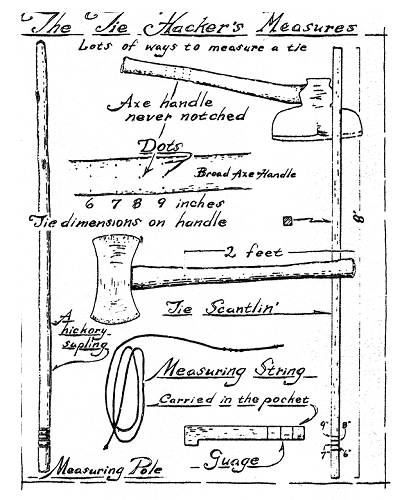
13 Tie Hacker's Measures
Click image for larger view
Dinner was also packed along, because working in the forest was an all day affair, requiring lots of hard work. A Mason jar, covered in a tow sack and wrapped with a string, kept the hacker’s water cool. A lard bucket protected his lunch, which often consisted of beans, fried pork, cornbread and an onion. He either walked or rode the mule to the work area.
Trees selected for ties had straight grain but were not too large in diameter, usually 11 to 13 inches, at the small end of the log. The trees selected had to be free of rot and holes. Logs that were too large in diameter yielded a tie and lots of chips, but men were paid or ties only, not the chips.
Railroad ties were 8 feet, 6 inches long. Switch ties, cut on special order, ranged from 9 to 16 feet in length and supported multiple rails at the switch assemblies. Until the 1940’s, most ties were hand hewed and, in Missouri, tie hacking represented a significant farm income.
Men worked as a pair until trees had been felled and cut to tie length. Then, working individually, they hand hewed or hacked a tie out of the logs. A tie hacker might say, “lay’er out and just knock off the juggles (photo 14).” However, skill and a sharp focused eye guiding a razor sharp axe were required to successfully hew ties.
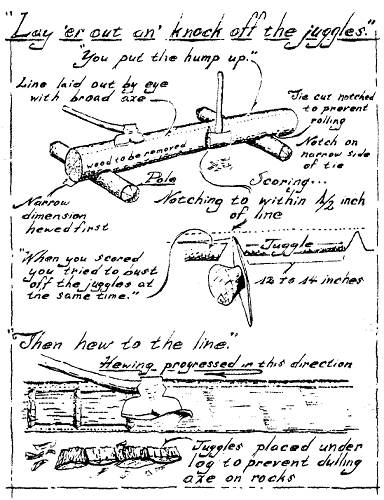
14 Juggles
Click image for larger view
Once a tree was down, workers measured logs to length using one of several methods. A pre measured, 8 foot long stick about 1 inch square, an 8 foot long hickory sapling, an 8 foot string or an axe handle marked in 2 foot increments could be used. On the tie scantling, workers cut axe handle grooves for gauging the 6 by 8 inch and 7 by 9 inch dimensions of the two sizes of ties that were hewed. The tie hack’s traditional method of measuring log length continues with some log cutters today.
A tie hacker notched a log slightly, to prevent rolling as work progressed, and laid it across two poles to elevate the work. If the log was not perfectly straight, it was laid with the “hump” up so the work cleared the ground. Next the hacker scribed a line with the broad axe by cutting along the length of the log, down its length. The cut line established the dimension of the tie. The double bit axe was used to score to within one half inch of the line and at the same time to break off chips (also called juggles). A slight twist o the wrists, as the axe stroke scored the log, allowed the juggle to split off.
The hacker stood so that his eye focused on the leading edge of the broad axe as he cut. The broad axe was used to hew to the line and to smooth the face. Hewing began at one end and moved backwards along the log. The hard part was getting the first two sides of the tie parallel.
There was a tendency to undercut and ruin the tie. A gauge, marked on an axe handle, showed the widths of ties and was used to measure for the final trimming and smoothing cuts that were done with the rear of the broad axe blade. The process was repeated on three faces (photo 15).
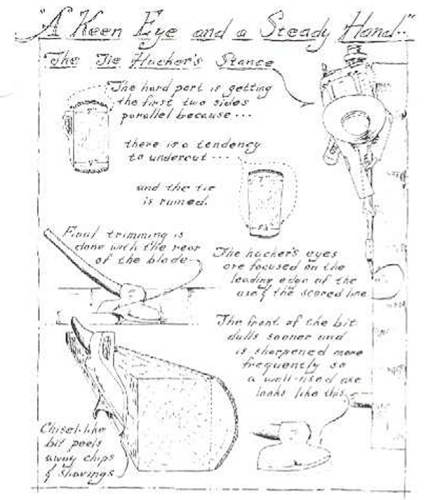
15 A Keen Eye and a Steady Hand
Click image for larger view
Juggles are 12 to 14 inch long chips which could not be sold, but they did have a key function. Juggles accumulating at the work area made a bed of wood that protected the blade of the axe from cutting into the soil and rocks below. Payment was based on the number of ties produced. Time spent sharpening the axes, after hitting rocks, was wasted.
Sharpening saw blades and axes was done with file and whetstone. An improvised filing vise was made by cutting a high stump from a small tree and then making a vertical saw cut. The crosscut saw was placed in the saw kerf, teeth up. The high stump allowed the filer to sit on the ground with the saw teeth about eye level.
The saw was held tight by wedging a small chip between the saw body and stump. One end of the saw was supported by a split length of limb driven into the ground, holding the saw body stationary. Teeth were flat filed and the hacker paid close attention to maintaining the correct tooth angles for best sawing. Saw teeth were of three types. Right and left hand cutters severed the wood fibers while rakers removed saw dust from the cut.
A broad axe head weighed about 5 pounds with a singe edge, 12 inch long blade. Sharpening the blade involved using a file and stone, but was only done on one side of the blade. The other side of the blade was flat, resembling a chisel, and resulted in a flat surface on ties.
Sharpening a broad axe involved supporting the blade against a small diameter log and stroking the file toward the sharp edge. The toe of the blade dulled rapidly, resulting in frequent filing and a blade that was wide at the heel. A corn cob served as a file handle. A tie hack owned only the essential tools, which were expensive and hard to get. Tool accessories, like file handles, were either home made or nonexistent.
Double bit axes weighed about 2 pounds and had two cutting edges. Tie hackers sharpened an axe by first sticking the blade in a stump and then filing the exposed blade. A whet stone was used in a circular motion to get a razor edge (photo 16).
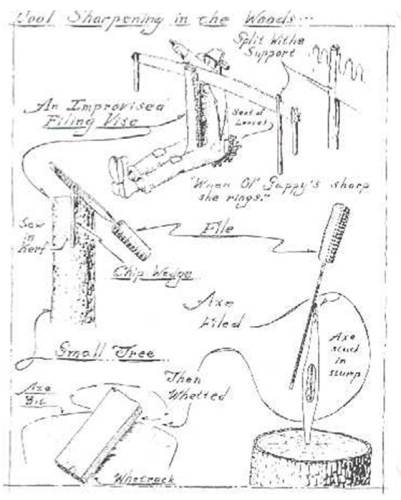
16 Tool Sharpening in the Woods
Click image for larger view
Once hewn, ties were transported by wagon or delivered to a river bank for assembly into a raft for tie drives downstream to a railhead. Tie hackers were paid at the delivery point. A good hewer could make 10 hardwood or 15 pine ties daily. In the 1930’s the price paid at the yard was 50 cents per tie, providing a grand sum of $5 to $6 for a standard 12 hour day. Later the price increased to $3 per tie.
Due to the low value received for ties, no money was paid to the landowner for the trees. During the 1930’s, as tie prices increased, the customary payment to the landowner was about 25 cents per tie. Trees containing two tie logs would be worth 50 cents.
At buying yards, such as the one at Bagnell, ties were inspected for rot, knotholes and the correct size. If the tie had a defect it had no value. Even small knothole caused ties to be rejected, resulting in no payment. It was sometimes difficult to judge if the underlying knot would be sound.
A tie hacker spent some time selecting a tree, felling it and hewing out a tie. If he discovered a small knothole he might try to hide it. The solution was to whittle a dead limb of the same species into the shape of the cavity.
The tie hacker plugged the hole by driving the plug into the knothole and hewing of the plug head with the broad axe. He might also rub a little dirt on it. Tie pluggin’ was a deceitful solution, but something many tie hackers did (photo 17).
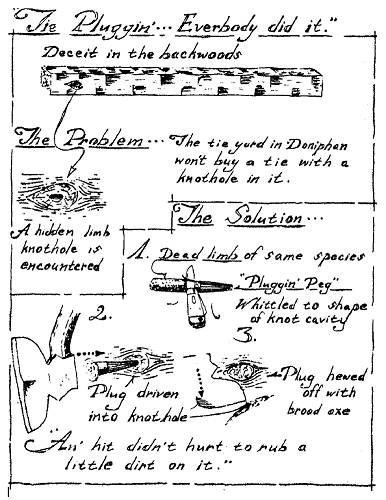
17 Plugging
Click image for larger view
Hand hewing of ties was doomed to become a lost art, but not without a fight. At stake was a loss of jobs on a nationwide scale. To supply the 110 million ties needed in the year 1900 it was estimated that 60,000 to 70,000 men were hewing ties. Another 50,000 men were involved in collecting, stacking drying distribution and sales.
Debate compared hewed with sawed ties. Proponents of hewed ties cited better resistance against movement when installed, plus two false premises stating that an axe cut closed the pores of the wood, making the ties more resistant to decay, and that sawed ties offered more opportunities for the wood to hold moisture.
Equipment manufacturing companies developed small, simple to operate and affordable sawmills suited for farm use. A farm tractor or a steam engine provided power for operating the mill. As mechanical technology evolved, fewer ties were hand hewn.
The life expectancy for the 110 million untreated ties installed during 1900 was four to six years. Ties are now treated with coal tar creosote, a chemical preservative and the life expectancy for a tie averages about 30 years.
In Missouri, a leading tie producing state, there were preservative treating companies in Springfield, Kansas City, St. Louis, Piedmont and Ellington. There are fewer but more efficient operations today. Environmental regulations control the application of creosote, and the demand for wood ties had been reduced. Fewer plants are needed to meet today’s demand.
The Missouri Department of Transportation reports that in 1991 about 7052 miles of track were in service in Missouri. About two thirds was in mainline quality track and the other third was in sidings, spur lines and rail yards. Main line track requires about 3700 ties per mile and a better grade of tie to withstand the rapid movement of heavy trains. The lower maintenance tracks required about 2900 ties per mile, including ties of a lower grade.
Research is on going to improve designs of spikes, rail bearing plates and ties made of concrete. To date, concrete ties, reinforced with steel, are in service in the Kansas City and St. Louis areas. In certain applications, such as high speed curves, concrete ties are holding up well. However, on most mainline track, wood remains the tie of choice.
Builders use retired railroad ties in retaining walls, raised ardens and other landscaping projects. Researchers are looking for solutions for disposal of retired landscape ties. One possibility is the use of the old ties as boiler fuel.
Railroads are important to consumers, farmers, and related businesses. Bulk cotton for clothing, lumber products for the construction of homes, fruits vegetables and grain, as well as autos and their parts, travel by rail. Although farmers no longer hand hew ties for an income, they continue to supply the wood needed for railroad ties and depend upon railroads to help link farm products with city consumers.
Magnificent steam powered locomotives have given way to the impressive, but not quite as romantic, diesel engines. Only a handful of steam locomotives remain in service, most on excursion lines. Although wood ties have undergone several modifications in their manufacture, it remains a fact that wood sleepers, made from a renewable natural resource, helped to support rails and trains.
Captain Henry Castrop was one of the most experienced steamboat captains on the Missouri and Osage Rivers. He was a good friend of Captain Bob Marshall of Tuscumbia. Captain Castrop wrote a series of articles for the Autogram about his experiences on the river over his many years of commanding steamboats. The next photo is the only one I could find with Captain Castrop; it is from an old edition of the Autogram and isn’t well copied. Captain Castrop is third from the left next to Captain Marshall (photo 18).
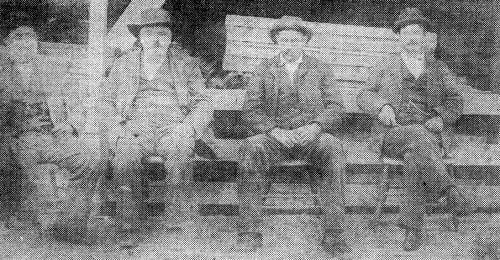
18 Four Steamboat Captains
The following narrative is about some of the men who manned the tie rafting crews which rode the ties down the river to Osage City. These men often were different than the farmers who cut the trees and trimmed the ties; the farmers usually didn’t follow the ties to their final destination. For example, the crew in this story by Captain Castrop were “pickups” and itinerants usually. The time of the story occurred before the Missouri Pacific had finished the railroad line to Bagnell so the ties had to be floated all the way to Osage City to be picked up by the buyers. The story occurs aboard one of the steamboats Captain Castrop commanded, the Hurlbut:
Steamboat Men and Tie Rafters
Captain Henry Castrop
The Hurlbut at one time had been engaged by a crowd of tie rafters, 36 in number, who, after landing their rafts at or near Osage City decided that rather than ride on the train to Bagnell and walk the rest of the way to Linn Creek to make it all the way up on a boat.
Those men liked strong drink and imbibed thereof until they were beastly drunk. When finally told that there was no more whiskey on board, some of the rowdier ones who would not believe his assertion, then drew their long knives and guns from their pockets threatening him “hand out or die!” Fortunately there were some who would stand with me between them and the bartender to protect him and fortunately, too, some were down on the deck too drunk to move. Finally, and all the crew of the boat, myself not excluded, were glad of it, the boat kept under a good head o steam and given all the advantage of the water possible by her pilot who on this trip was Captain William Towns, the then oldest pilot on the river, we reached Linn Creek where, on the opposite bank of the river, they were, with no little difficulty, put ashore. One of them, the leader of the bunch, a stout fellow but of no mean disposition, whom I assisted in climbing up the steep bank, tumbled as we had nearly reached the top and he and I rolled back down to the water’s edge. Extricating myself as fast as was possible from his embrace, I jumped aboard; the boat was backed out into the river and our “esteemed” passengers left to their fate on top of the bank and their comrade and chief at the edge of the river where he was allowed to sober up on water.
It was on one of these excursions that there were three tie raters on board who had taken passage to Rice’s. One of them soon became disturbing and using language very objectionable to the ears of a refined class of people as we had then on board. Not heeding my advice to either behave or be put ashore I had the pilot to land the boat and taking the fellow by the collar I pushed him to the gang plank when suddenly he was wrenched away from me and laid down on deck by the hand of the yet stronger veteran of the civil war, Captain F.G. Schoenen, who had seen the fellow draw his knife making ready to get rid of me. “Will you now lie still and behave!” Captain Schoenen commanded. The fellow promised and he no more opened his mouth nor did he move an inch from where he was placed until the boat landed at Rice’s where the trio was put off. When the boat had backed away from the bank, her departure ws then saluted by a hail of stones thrown on her decks by the ruffians which, while it lasted until the boat could no longer be reached by these missiles, were dome very uncomfortable moments or the excursionists. Had these enraged passengers found a loaded gun aboard, these rafters would have floated their last raft down the Osage River and no more would they have annoyed passengers and crew of a boat going upstream.
By describing these incidents I do not mean to put all tie raters in the class of the rough and uncivilized. There were of this profession some not at all objectionable to society. Among them were the Swedes employed by the Nelsons, who at that time had their tie works and camps in the timber lands along the Osage near Babtown. These, though they, too, would seldom indulge in strong drink, would not become unruly and act as madmen. They were jovial fellows and the melodies of their songs (words were not understood) were much enjoyed by all on board.
Rafting was by no means an enviable profession. But only was the crew consisting of but two men on most rafts, exposed to the weather for weeks, the swinging and pushing of the large oars affixed to both ends required hard strain of the muscle when the backwater from the Missouri River in the lower Osage often extending as far up as Bloody Island was struck, the raft would no longer float down stream but with the wind against them, move back up stream. We were often called upon to tow these rafts, more of them coupled together, to Osage City. This work was mostly done at night. After the boat was hitched to the stern of the raft, the rudders were set to the course she had to run, the helm tied down and the pilot’s only work was to watch that she was keeping this course, which, on a straight stretch of the river and calm waters, she would do for hours. A bend or curve in the river, of course, would demand a changing of the rudders. As the boat with a large raft in tow would make but slow headway, it was all night and then some before she reached Osage and not having much to watch, a pilot would often take a good nap at the wheel. One night having a straight river to run from the Shipley shoals to Lisletown I had miscalculated the time. The boat had either developed more power than usual in making this stretch or I had napped overtime. When I awoke the bow of the raft was pushing against the big bluff and neither boat nor the raft was moving. Ringing the backing bell, which after a while was answered by the engineer, Mr. Grant, who evidently, too, had also lain in Morpheu’s arms embraced, she was backed into midstream, straightened up to her course and after several more hours was handed at Osage.
That nature’s needs must finally be appeased or yielded to is proven by another incident. Coming down stream one night, all of the crew having been without sleep the two previous nights, had fallen a victim to sleep. The Hurlbut on her own accord, she being no longer able to turn the wheel for lack of stem, landed herself below Lisletown. The crew, awakened by the light jolt against the dirt bank, was told to tie her up until morning. They had aimed to make it into Osage, but close as it was, this port was not reached that night.
The tie industry along the Osage and its tributaries was quite prevalent all long the river’s course through the heavily wooded Ozark hills which included most of the river up to where it left the more flat and less forested areas of western Missouri. The following two articles were written long enough ago to have obtained first person interviews from some of those actually involved with the rafting work years ago. The first one is from the Bittersweet publication written by Todd Waterman in 1981. At this time this article has been placed for public viewing on the internet website:
http://thelibrary.org/lochist/periodicals/bittersweet/wi79i.htm
It is a long essay but I found it very interesting. It covers quite well the history of rafting along a number of Ozark streams including the Osage:
THE RAFT
FLOATING RAILROAD TIES ON OZARK RIVERS
by Todd Waterman
"To the best of my knowledge, me and my father, Ed Graven, and brother-in-law, Bill Lindsay, rafted out the last railroad ties that ever came down Beaver Creek. I was twelve years old and this was in 1919. I believe there was a hundred and eight ties that had been stacked and delivered to the landing up on the bluff above Beaver Creek," Vernon Graven said. "We was a-plowing corn in June when Bill Gater who worked for the tie company came down, and he offered Dad two cents a tie extra if we would quit and take them down the creek to the Gasconade River and to a point near Richland.
"We nailed the ties there together and picked up all the ties that were down at Beaver Creek where it empties into the Gasconade, and then we went down to Competition and finished up with three hundred ties."
This experience of rafting railroad ties to market is one of Vernon's most treasured memories. "I've lived that trip over in my mind so many years," he said. He got in on the tail end of a fascinating occupation.
Lee Berry made his first trip in the 1890's when he was eighteen years old. "I made about five or six trips that fall. Then I run every year after that for about fourteen or fifteen years."
"That was his life," his daughter Geraldine Brewer said. "He loved to raft. He farmed, too, but he couldn't hardly wait till he'd get his crops laid by, then he could raft."
Those of us who enjoy floating the Ozark rivers today can understand the excitement, the allure and satisfaction these old-time rafters must have felt as they took raft after raft down the river for years through the sparcely populated and still wild region.
"All ready? Let 'er go," one of them would shout. With long poles the men would push the long, unwieldy looking craft into the current. It would gradually pick up speed as the front disappeared around the bend in the quickening current. Within minutes the sounds at the tie bank would be gone as they began their week long dependence on the river and their own skill to float the fifty to seventy-five twisted miles to the nearest railroad yards.
[44]
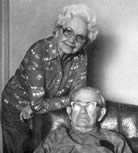
Lee Berry and his daughter Geraldine Brewer reminisce about rafting days on the Niangua River. by Todd Waterman
As we float those same miles today, we wonder how they floated these eight foot wide rafts when we sometimes have to portage a canoe. Lee explained, "The river ain't anything like it was. There was lots more water and not hardly any gravel and sand bars. It was a bigger river."
The advent of the truck and improved roads and bridges to haul the ties to railroad centers stopped the tie rafting on the Ozark rivers which had began in some places before the Civil War. The nation's expansion to the west and demand for more railroads created an insatiable demand for ties for the railroad beds. Every one of the 209,000 miles of track laid in the United States needed 3,500 ties. Since the ties lasted from twenty to sixty years, even after the era of expansion was over, railroads constantly needed many replacement ties.
Millions of these ties came from the Missouri and Arkansas Ozarks. In 1912 alone, 15,000,000 hand-hewed ties were sold in Missouri. The area became a huge supplier of ties, not only because the timber was there, but because the labor to cut the ties was available in the comparatively poor agricultural region. In places where the land was richer, people would not cut ties even if timber was there, for farming paid better. In the Ozark hills where most did subsistence farming, cutting, hewing and rafting ties to market provided needed cash income for many families.
Even though very few tie rafts were floated to market after 1920, many people continued to cut and hew ties by hand as late as 1935. During the early Depression, selling ties kept many families from complete ruin. Then about 1933, when the market for stave bolts opened in the region, people quit making ties, for they could make more money with less labor cutting and selling stave bolts. Also about this time railroads began using ties shaped at the mill. They did not use saw milled ties earlier for they had thought hand-hewed ties lasted longer.
Tie cutters got the timber wherever they could. Some cut on their own land, some paid a fee to landowners to cut; others cut without permission on absentee landowners. Men in the business would sometimes acquire timber land very cheaply by purchasing tax-title land and cutting the timber off of it before reselling the land.
[45]
The process of making railroad ties was a laborious task. (See Vol.V, No. 3, pp. 75-78, "Tie Making.") With an ax or a one or two man crosscut saw, the first job was to cut down the tree, either white, black or some hard oak. Then the men hewed out the the tie to the exact measurements using both a broadax and a chopping ax. The sizes of ties varied, but the most usual size was eight feet long, eight inches wide and six inches thick. Cutters preferred bigger trees because they could make two or more ties from one tree. Earl Ripley said, "Getting four ties from a tree they called quarter tie. We had one that was called a bastard tie. That was a tree that made six ties to the cut, and a cut that just made two was a half moon tie. Then the smaller trees that you just made one out of was a pole tie."
Hewing the tie was a slow process that took practice to do correctly. Hewers used a double bitted chopping ax and a twelve inch broadax. First they cut a line down the bark of the tree to mark the dimensions of the tie. They then chopped away the bark and shaped the tie one side at a time with a broadax until finished. Most men could cut and shape between ten to twenty ties a day.
Everything about the tie business was done by manpower, even carrying ties. Men who worked with ties and rafted them soon mastered the knack of carrying the 200 to 300 pound ties on their shoulders. Vernon remembered a man who worked at his sawmill carrying a sixteen foot by seven inch by nine inch tie up the gang plank to the boxcar on his shoulder. "I seen the man do it," Vernon said. "That is unbelievable. It'd weigh seven hundred pounds. The way the old-timers out in our country figured, when a boy got to be a man was when he could take a tie on his shoulder, carry it and put it on the landing. It wasn't no easy job. We used to laugh, 'That guy can't even carry a tie. It wasn't no disgrace, but it made him feel bad at the time."
Men who cut ties often made ten to twenty a day. Years ago trees were big enough to cut more than one length and as many as six ties to a length.
Ties were hewed by hand with the broadax and the chopping ax.
Logs were sometimes loaded on wagons to be taken to the sawmill or to be hewed on flat ground.
Large numbers of ties were hauled to tie banks. Woodsmen cut ties from tall straight oaks with crosscut saws.
At the tie landings, the buyer would brand his ties in one end.
Those experienced in carrying ties would be able to guess the center of the tie and not miss it more than a half pound from perfect balance. In tie yards a man that loaded ties would have two men place it on his shoulder, but a man out in the timber cutting ties would have to put it up on his shoulder himself. He would stand the tie up on end and then let it balance back on his shoulder. Earl said, "Oh we'd always pack them. Wasn't no trouble to flip a tie on my shoulder. I was stout then--pack it up the biggest hill. Maybe we'd throw our cap on our shoulder. It will kind of wear your shoulder out if you don't. Them men that loaded ties at the yards had pads on their shoulders. You can tell it on my right shoulder, for the bone don't stick up as high in it."
Since ties were often cut in steep hollows inaccessible to the wagon and team, the cutters would often have to carry them up the hill to load on the wagon. Some wagons would carry twenty to twenty-five ties, but most hauled from eight to sixteen.
In many areas too far from railroads to haul them by teams to market, it was more economical to float them down the rivers to railroad centers. The individual cutters often hauled their own ties to the river bank.
At the bank, which was usually a bluff or a steep hill right by the river, buyers would purchase the ties. They gave so much for hewing, so much for hauling and stacking. If someone other than the hewer hauled and stacked them, they got a few cents per tie for that. The inspector would cull out any that weren't the correct size, had any bark showing or were in any way inferior, such as signs of having lain on the ground. Earl said, "I'm going to tell you the truth. You might have both ends of that tie just as solid as a jug but if it was holler in the middle, he would know it when he hit it by the sound of the hammer."
Ties were sold at many different bankings along the rivers. In 1910-16 ties brought ten cents in the woods and fourteen cents delivered to the river. Later in the 1930's, they brought up to forty-five cents hauled by truck to tie yards in town. But back in rafting days, the tie buyers were often owners or managers of local stores. Sometimes they paid in script--redeemable only for merchandise at the country store. This amount doesn't sound like a very large sum of money for the labor involved-about $8.00 for a wagon load of ties, but Earl said, "Lord God, you could buy a whole wagon load of groceries with that--eat a meal for fifteen cents and stay all night--two sleep in the bed, twenty-five cents."
The sold ties would be banked up close to the river. Sometimes there would be huge numbers of ties ricked up in stacks of hundreds or thousands in a clearing of maybe an acre located where they could be pushed off the bluff down the tie chute into the river. These banks were not necessarily high bluffs. A bank might be as close as ten feet from the water's surface or it could be 400 feet high. The important thing was that there be an eddy, or pool--a big enough body of quiet water below the bank to catch and hold the ties so men could nail them into rafts before they washed on down the river.
The ties brought to the bank had to be stacked in a certain way high enough that floods or high water couldn't reach them. They were stacked with one layer one way and the next the other way to allow air to flow through to season them and prevent decay. The ties might have been stacked for some time to be well seasoned. If they were green and heavy, they'd bank them in the winter to float out in the spring or next fall. But even with the seasoning, some ties wouldn't float. Geraldine Brewer said, "Sometimes they'd throw ties in the river and lose them. There's a lot of them old ties in the river yet that got sunk and they couldn't get them out. They used to call them 'old sinkers.'" A few ties which wouldn't float would be put on top of the rafts. The seasoned ties floated high in the water clearing the shallow riffles.
While the ties were stacked on the river bank, the buyer would usually brand his ties. These brands were normally a small letter or symbol a blacksmith made similar to animal branding irons, only these were made, onto a hammer. The brander would hit the tie on one end to print his brand.
After there had been enough ties brought to the bank to make a good raft, the buyer would hire men to raft them down river. The rafter's job usually was to do all the work from pushing the ties off the bank to delivery at the railroad, though sometimes different crews would build the rafts and float them. Sometimes men rafted only certain sections of the river, delivering rafts to others who continued to the railroad.
[48]

Tie bankings varied from a few stacks to an acre of cleared land on top of a bluff or other bank where the men could push them into the river and form them into rafts.
Rafting began each year after danger of freezing was over and continued into the fall. On smaller streams there would be enough water only in the spring after lots of rain. Often during midsummer, due to lack of rain, the water became too low to float the rafts over shoals. Fall was a good time for rafting, for the weather was usually good and the winter-cut ties would be well seasoned by then.
When conditions were ready to raft them, the stacks had to be pushed into the river. Earl said, "They had a chute they run them ties off of, and then they'd hit that bluff and they'd just upend and go everyway. But it would all be eddy water below to catch them. I've seen them ties piled up and down the bluff. You've got to be careful. Boy, if they'd tear loose, then they'd kill you."
Lee Berry remembered one time they threw 1,500 over the bluff. "I'll never forget. They lodged about halfway down the bluff. Then we went across the river to eat our dinners. When we started back to tear them loose, well, it come up a rain while we were going up the bluff. We got up there to where them was all piled and scattered around, and we kind of tore them loose. They went right down over that bluff, and most of them went on down the river. They just floated off and we had to catch them and nail them in. We had a lot of things we had to do."
The hundreds of ties sliding down the chutes knocked down all trees and brush. The chutes were completely bare. Though no ties have gone down them for over fifty years, some of the slides are still visible because of the stunted vegetation.
After ties were in the river--or if there were enough men, while the ties were being pushed into the river--men below wading barefooted in the water would pull, push and work the ties into order and then nail them into sections. The current would be slow enough they could make a sort of corral of ties to hold them.
The men in the water used poles from split sapling to fasten the ties together. They had gone into shady timber to get tall, straight saplings about four inches in diameter and about fifteen feet long which they split down the middle. These were called binders. Geraldine Brewer said, "It got to where they had most of the good binders cut out of the woods. Sometimes they'd have to hunt around quite a bit to find them because with so much rafting going on, they'd cut most of them and, of course, they couldn't bring them back to use again."
[49]

Ties by the thousands choked the quiet river eddies ready to be nailed into rafts and floated to market as far as fifty to seventy miles downstream.
The men positioned the ties side by side about four inches apart. They placed the binders near each edge of the row of ties and nailed them down with one twenty-penny spike nail in each tie. They would make one section, or block, with about ten to thirty ties depending on the length of the binders. Rafts were built sort of like railroad tracks, only the ties were much closer together and the binders were in place of the rails.
The men would then fasten two blocks of ties together with a coupling made of a shorter sapling split in half and nailed to each end. They drove one spike through the sapling into the center of the third or fourth tie back in one block, and the other end to the next block, making a coupling with a foot or a foot and a half space between blocks. With the spike acting as a pivot point, the raft was able to bend around the many curves and crooks of Ozark streams. The men nailing in would continue building blocks and coupling them together until they had built a raft of about fifteen to twenty blocks, comprising 700 to 1,200 ties. The rafts were anywhere from 200 to 300 yards long and were very stable, hardly moving under the weight of a man as he walked across them. Lee Berry said, "We got to running a thousand in a string. Sometimes you couldn't see the feller that was with you. He's be somewhere back around the bend. 1,400 was the most ties I ever run."
[50]
The river on which the ties rafted was a factor in deciding the style of raft construction. The more crooked the river or stream, the more flexible the rafts had to be. On smaller rivers or creeks, like Beaver Creek in Wright County, Ed Graven used a different means of fastening ties together. Instead of the center coupling, he extended the smaller ends of the two binders over the gap to the next block. The white oak saplings were green and would bend without breaking as the long raft would snake around the turns of the creek. Rafts on smaller streams could not be as long as on larger rivers such as the Gasconade, Niangua or White.
As soon as the raft was complete, men would float it down the river. It took at least two men to guide the raft, wielding fifteen to twenty foot long poles to push, turn and stop the raft. The man at the front, the bowman, would guide the raft by keeping it in the current, and he would yell instructions and warnings to the man at the rear, the snubber. The snubber's job was mostly to snub, or brake, the raft by dragging his pole against the bottom.
When building the raft, the men allowed more space than usual between the second and third ties from the stern end. The binders on these ties were double nailed through the big ends. The snubber stuck a long, strong snub pole of about three inches in diameter between the ties down to the river bed. His was a heavy job. Bracing the pole against the ties, he had to push down against the river bed to control the raft's speed or to stop it altogether. There was usually no need for snubbing in the eddies where the current was slow, but when the front end of the long raft would enter a riffle or was going to make a bend, the bowman would call back, "Snub 'er down!"
Vernon Graven explained, "You'd hit some fast water. The end of the raft would be a-pulling too fast and you knowed you were just going to tear up, so you had to brake it down just like when the car's going too fast down hill, you got to use your brakes. And so that's what we did--snubbed it down with that pole. We had to cut a few snub poles in two, for we got snubbing in pretty deep water, and then it'd start getting shallow and that pole would bind between them ties till you wasn't powerful enough to pull it out. So what could you do? You had to cut this pole off right there at the tie and let it drop through."
Occasionally there would be a third or fourth man on the raft, called polers. They stayed in mid-section to keep the middle away from trees, banks or rocks and to push around bends. To pass over shallow riffles or to keep moving in eddies, they would pole by pushing on the bottom.
Besides strength and skill, it took a knowledge of river conditions to take a raft downstream. Tie rafters preferred the river when the water was receding or falling. In any stream low water is sluggish, causing floating objects to drag over shallow riffles. Rising water bulges in the center, sending floating material to the side, thus making it harder to keep in the current. Receding water has a slightly sunken middle, a sort of trough which holds floating material. This condition made rafting easier.
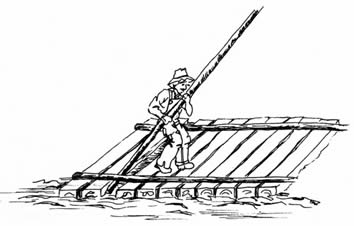
Rafters split saplings to make the couplings in the middle and the binders which were nailed down each side. At the stern there would be two or three extra ties double-spiked for the rafter to stick his snub pole through when braking.
[51]
Even in the slow eddies, the bowman had to watch to keep the raft in the center to avoid the back pull of the water in places where it circles and comes back to the bank. But usually floating the long eddies was a rest period. Vernon said, "When we hit those long eddies, all we had to do was keep it in the current and let it float. In those great long eddies on the Gasconade, we'd even sometimes pole it to boost it along a little bit. It'd pert'neer come to a stop, so we'd bunch up and talk. Like take the Dougan Eddy above the bridge on AD that is about a mile long. I remember we all got together, smoked our pipes, chewed tobacco or done our thing. All we had to worry about was not to let the raft get to one side where the current backs up. As long as we had it in the stream in the middle of the river, why it took care of itself in those long eddies. We'd have one-half hour rest."
But going over the shoals, or shoots, and around short bends was another story. Earl said, "They were hard to work around some of them bends. You'd be surprised, that many ties in the water how much power they have. They won't go fast, but they'll just keep a-pushing. They'll push and double up on you if you don't watch it."
Vernon said, "When we was going around the curve one of us would walk on the raft with that pole and push with our feet to make the raft float around an object. In some places where they'd be an old tree stump or a rock in the edge of the water, we'd have to do that, or where the river would bend pretty sharp. That's the way we kept it from grounding."
Rafters had to be alert for unusual conditions or problems. In low water, they would make temporary brush dams across shoals to deepen the water enough to float them. In some places millers had dams across the Giver. Though there was a runway through which the rafts could float, an occasional miller was contrary and made rafters pay a toll for him to open the gate.
While floating Lee Berry often had to do some fast thinking. "We got down to where there was a crook in the river. There was a big sycamore tree had fell across that river and about half of the log was in the water. My brother was snubbing and I hollered, but he couldn't stop it. So I run my push pole under that log and those ties went right down under that log and come right up on the other side. I jumped over that log and hollered back to my brother what he had to do. We went right on out and when he came down, why it drug his push pole off. We had to stop and go out in the timber to hunt some poles. That's the way we'd do a lot of things that happened. A lot of times we wouldn't know anything was even in the river till we got down to them."
Vernon had a similar experience, only his log was not in the water but about twelve inches above from bank to bank. He was at the end by the grub box. "They begin to holler, 'Tree!' They were both pretty well at the front end. When I seen it, I dropped down right in front of that box. I don't believe it cleared that box four inches. There's nothing I could do about it. I started to lay down behind the box, but thought, boy, I don't want the box on top of me, so I jumped up in front of it. That kind of give me a thrill. You remember things like that. The others probably just put their hands on the log and jumped over it."
At times the raft would get wrecked or torn up on the trip. Then the men would have to make repairs. If the tail section broke away from the main raft, the snubber would have to carry on alone to catch up and tie back on. The bowman was in trouble until he reached a long eddy and could see the end of the raft.
During favorable rafting conditions, there might be other rafts on the river. There was the possibility of running into one around a bend or being rammed from behind. But that wasn't very likely. If the raft was very close, the men could usually hear the rafters' instructions shouted to one another. A trick to hear one farther away was to put an ear in the water. The water transmitted the sound of the snubbing pole gouging the bottom from quite long distances.
[52]

On the trip rafters would pick up lost ties, or sinkers, from earlier rafts.
The rafters took with them only the essential equipment--ax, hammers, nails and ropes for repairing the raft, and necessary food and supplies for themselves for the length of the trip, for they'd have to carry everything back home on their backs. Vernon's father built a discardable oak box on the end of the raft for their food and camping outfit. They covered it with a wagon sheet, which doubled as a ground cover to sleep on and as protection from rain. Some rafters built cross pieces on the raft to keep their belongings up out of the water.
The men would raft all day until near darkness when they would tie up in an eddy to stay for the night. Earl said, "One old rafter, Fred Johnson, had a cabin that he placed on the raft that he stayed in." Some would take along all their food and camping materials needed to cook and camp right on the river. Vernon talked of making biscuits by first letting the fire burn down to coals. Then they put the biscuits on an oak board greased with bacon drippings and placed the board beside the hot coals. "We'd stir them coals to keep them bright. You'd be surprised how good the biscuits tasted. We had worked in that water all day and we were wore out and very hungry."
Many who rafted frequently had regular stops where they would stay over night at nearby farmhouses. They'd pay something like fifteen cents for a meal and usually nothing for bed.
In the sparsely populated area where visitors were rare, the rafters were welcomed by people in most farmhouses. Geraldine Brewer who lived as a child on the Niangua River, remembered her excitement when rafters would come. She could hear them shouting instructions to one another on the raft long before they reached her house. "I've seen three or four rafts come down in a row. We used to hear them yell about two miles up the river. My brother and I would take off to the river to see the rafts go by. Then, when they was going to stay all night or have dinner with us, why we just thought that was a big treat. We'd run to the house and tell Mama, 'The rafters are coming and they're going to be here for dinner,' or 'They're going to be here for the night.' Then Mom and Dad and the rafters, they'd sit and play pitch at night. They used to talk rafting--that's all they talked. They knew every sandbar, every snag, every shoal, every eddy by name. If Dad wasn't running just then and the rafters came by, he'd ask them, 'Now how did you run such-and-such a place?' or "How did you run Iron Holes?' They'd tell him. Maybe it had changed. "Well, there's a bar at such-and-such place you have to bear to the left.'"
[53]

After reaching the railroad center, ties were shipped to plants for processing. Stacked by the thousands in crisscross fashion to prevent decay they were then ready for shipping all over the country to build or repair tracks.
The men who rafted had the whole river nearly memorized, so they could know what to expect. But on each trip the river might be different. After high water they expected some changes. The rafters on the Niangua usually spent from three to six days on each trip depending on the starting point and the water level of the river. Most of the rafters on the Niangua River would stop at Old Linn Creek on the Osage River. This, of course, was long before there was a dam at Bagnell forming the Lake of the Ozarks. There the Osage river was wide enough that the rafts would be nailed together four abreast, and usually another crew would float them on down to Bagnell where they were dismantled and the ties loaded on railroad cars and taken to tie yards. At tie yards ties were loaded on trams--circular, topped rail cars--and taken through the processing plant where they were heated in creosote so that pressure forced the solution into the wood. 800 ties composed a charge which was treated at one time. One of the biggest yards was in East St. Louis.

[54]
The hardest part of the rafters' trip must have been the long walk back home. The only transportation at that time, of course, was horseback, and it was obvious they couldn't take a horse with them on the raft. They had to carry their equipment and walk home. The walk was straight across country, not as many miles as the crooked river trip. Lee Berry used to put in at several different landings on the Niangua River. The trip from Corkery, for example, where he often started, to Old Linn Creek would have been over fifty river miles, but the walk back was about twenty miles to his home at Celt, which was about eighteen miles downstream from his starting point.
Some walked as much as fifty or sixty miles. Vernon said, "We walked the forty miles back home through the woods." His river mileage would have been close to seventy miles. "We'd go up to farmhouses, for we'd run out of food, and we would buy eggs or something to eat. Sometimes a farm lady would bake us a pie. We'd give her a dime or fifteen cents for a pie. We'd never have nothing for nothing. Of course, we could have went up and eat, for they'd asked you to come up. People in them days was so scarce and far between, they was glad to see you come and talk with you."
The men were usually paid for their work on delivering the ties or after they returned to the place where they had nailed in. Most often they were paid cash. The money that they received was good wages for that time, better than cutting ties. Lee was paid a dollar and a quarter a day. Some rafters contracted the trip; some were paid so much a tie. Vernon remembered that they got twelve cents apiece for delivering the ties they began with. For the ties that were on previous rafts that had broken up, they got ten cents each for picking them up. "We were well satisfied with the trip," Vernon said.
The big virgin timber has long been gone from the woods. Even second and third growths have been cut and the tie hewers have long since disposed of their broadaxes. The tie chutes have grown up while the lost ties still in the river have almost all rotted away. The rivers are silting up, and the many people who now live along the banks are busy with farming activities, vacationing and resort businesses. The old rafters left, like ninety-nine year old Lee Berry, have only their memories to remind them of the days when with pole in hand, scanning the approaching shoot which rumbled and sent spray in all directions, they used to stand on the bow of a raft made of a thousand ties.
"Snub 'er down!" they'd shout as the current pushed the raft to the left toward the root-entangled bank. "Bear to the right. Snub 'er down!"
We'd like to express appreciation to D.B. Mabry, Editor of CROSSTIES for all old photos.
[55]
The second article about tie rafting was written by Jefferson Blount many years ago and was placed on the internet by a relative of Mr. Blount’s, Donna Blount Fisher.
The information on this site is interesting as it discusses rafting on the Osage in the area of where the Lake of the Ozarks exists today:
Rafts sometimes exceeded two thousand feet in length, though most were only a few hundred feet long. The raftsmen stationed themselves along the length of the floating boardwalk and guided it with poles--those at the front actually steering the raft while those at the back acted as brakemen, or "snubbbers."
In most summers the Osage River fell very low, scarcely more than a foot or two deep. One of the shallowest places in the lake area was Mining Port Shoal, where the Osage River crossed over from the south bluffs to the north bluffs.
The following excerpt, written by Jefferson Davis Blount, of Linn Creek, illustrates the difficulty of getting tie rafts through the shoals:
"I was 18 years old and it was at the toe of Horseshoe Bend, just below Cape Galena. We put in ten thousand ties, started down the river on the 15th day of August, 1879, and we was 31 days on the trip [to Osage City].
"The river was at a dead low stage, and the first day we got to Mining Port Shoal, a distance of three miles. There we had to cut free the first raft and make dams out of it so we could get through with the other rafts. Then we had to pry the first over with hand spikes. My, but it was hard work. We had to lift all we could and then some more, and I mean we had one hell of a time at Mining Port."
(Mining Port Shoal, the bane of all tie rafters, is now in the deepest reach of the Lake of the Ozarks. Located at mile marker 5, it is under one hundred feet of water!)
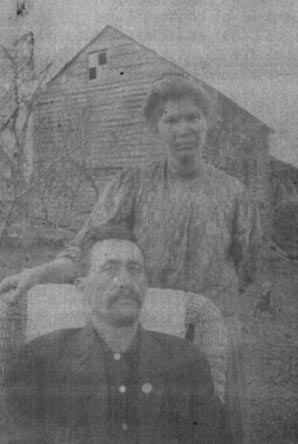 Jefferson Davis Blount, and wife Sarah Stubblefield Blount, taken circa 1890. J.D. lived to see the Lake of the Ozarks; some of his Camden County land was purchased by Union Electic in February, 1931. J.D. died in 1934, and is buried in Conway Cemetery, Osage Beach. (Photo courtesy of Donna Blount Fisher, Kansas City, Missouri.) Jefferson Davis Blount, and wife Sarah Stubblefield Blount, taken circa 1890. J.D. lived to see the Lake of the Ozarks; some of his Camden County land was purchased by Union Electic in February, 1931. J.D. died in 1934, and is buried in Conway Cemetery, Osage Beach. (Photo courtesy of Donna Blount Fisher, Kansas City, Missouri.)
Blount's tie raft averaged only three miles a day and took a month to reach Osage City.
Upon arriving at the terminal port--either Bagnell or Osage City--the rafts were broken up. The individual ties were taken out of the water, counted, and credited to the supplier whose mark appeared on each one. Eventually the ties were shipped by rail from the wholesaler to the individual railroads.
The tie rafting business began to decline in the 1910s. Competition from other regions and the closing of the rivers by Tunnel Dam and Bagnell Dam eventually put an end to the local industry. It proved too costly and difficult to haul the ties by wagon to the nearest railhead.
Some tie chutes are still visible today along the lake shore. One is on the Glaize Arm in the state park at mile marker 12. Look for the orange and white buoy marked "A". Another, pictured above, is on the main channel at mile marker 38, near the north end of Hurricane Deck Bluff. And according to Blount's account, yet another should be visible near Galena Point, at mile marker 8.
The Missouri State Conservation Department sells a historical video about the production of railroad ties in Missouri. It is named “Stamp of Character.” It is very interesting because it comes from archival black and white footage of the last railroad tie drive made on the Black River by the T.J. Moss Tie Company of St. Louis. I have a copy of this video now being available in DVD format and highly recommend it. To order, you can contact the Department office at:
Missouri Department of Conservation
Media library
PO Box 189
Jefferson City, Mo. 65102-0180
The story about the poultry industry in Miller County a couple of weeks ago elicited a couple of comments from readers Dub Brown and my mother, Susie Pryor, who had some things to say about laying hens.
First, is Dub’s letter (photo 19):

19 Elmer Brown
FIGHTING COCK
Mother always kept about a hundred hens and a dozen roosters and sold hatching eggs. White eggs commanded a premium price because consumers preferred them over brown eggs. For many years the White Leghorn was the premier egg producer, hence we kept leghorns and produced eggs to produce leghorn hens to produce eggs for the consumer.
In the mid forties the broiler industry began to takeoff and the market wanted a chicken that was faster growing and meatier than the leghorn. A particularly popular chick was a cross between the Rhode Island Red and the White Wyandotte. Mother switched so we had red roosters and white hens.
She usually purchased two or three hundred day old chicks each spring and raised them to begin producing eggs in the fall. Normally she would get 100 pullets (determining the sex of day old chicks is fairly easy if you know what to look for) and 100 straight run. She would also buy 25 Rhode Island cocks to be kept. Once the cocks from the straight run group got to be about two to two and a half pounds we ate a lot of fried chicken. Originally we had two hen houses with chickens assigned to each on the basis of year group. In late summer each year the two-year-old hens were sold off as stewing hens to make room for the incoming crop of pullets.
One of my chores was to carry feed and water to the chicken houses. One year one particular rooster began showing signs that he was challenging my right to approach. I found this pretty interesting and, being about 13 and beginning to feel my oats, no small threat to my authority. I began carrying a stick with me and the battle was joined. He would attack and I would fend him off with the stick. This would go on until the rooster got tired or I ran out of time.
One day I was in a hurry for some reason and forgot to pick up my stick as I approached. I also had my mind on other things and totally forgot about the rooster. He hadn’t forgotten. By this time the rooster had gotten pretty good at launching sneak attacks from the rear. Normally I would pretend to not know he was coming and then at the last minute, turn around and fend him off.
I realized my mistake when he landed on the back of my legs and began working me over with his spurs. Those things hurt and he was getting in some pretty good licks. More to the point, my pride was hurt to think I had been so easily fooled and my quick temper overcame common sense in a flash.
I dropped my buckets, grabbed a rock about the size of a golf ball and let fly. I suppose I aimed for his body but really expected a near miss to scare him away. To my surprise and horror the rock connected squarely with his head.
He did a back flip and never moved a muscle once he hit the ground. Oh, my God, what will be my punishment for killing one of these expensive roosters?
Since we had quite a few roosters about the only way to tell if you were one short was to count them by aid of a flashlight when they were on the roost in the house at night. I figured there would be a pretty good chance it would be some time before mother did that and hopefully she would figure any missing had been grabbed by a fox. If questioned, I could certainly suggest that as a possible explanation.
As I was thinking this through I was also realizing that I had to get rid of the evidence. I picked him up by the feet, never thinking to check for a heartbeat, and stashed him behind a nearby brush pile. My intent was to return later when I had more time and carry him up into the woods where I knew the scavengers would eliminate the evidence in due time.
I went on to school or where ever it was I was going. When I returned I sneaked out to the concealing brush pile to dispose of the carcass. To my surprise it was gone. My first thought was that mother had found it and was waiting to confront me and demand an explanation. I was on pins and needles all evening but nothing was said.
The next morning, still puzzled and apprehensive, I went out to feed and water the chickens. To my surprise, my adversary met me as I approached the hen house. He made a show of challenging me but it was evident that his heart wasn’t in it. That suited me just fine. I was willing to drop the issue if he was.
Thanks Dub.
My father moved from the farm to town with his family when he was a young boy after my grandfather was elected to county office down south in Wright County where they lived. So he never knew much about taking care of laying hens. At least, that is how I would interpret the next story from my mother:
I was going to tell you about mine and Daddy's experience in raising chickens. He built a chicken house and bought some, I think you called them Bantys, and it was quite an experience. We bought them already hatched and we had no trouble until they got big enough to roost and they wouldn't go inside the house to do that and started roosting up in the trees and we had a good many too. That was all kinda embarrassing for we neither one knew anything about raising chickens. Your last article reminded me of that time. It was before you were born. Boy, we started eating them when they got barely big enough and we had fried chicken every day. He finally got in and somehow or another fixed boards up high and they quit the trees and started roosting up high on the roosts he made for them. They looked a sight when you looked out and saw all those chickens up in the trees. My dad told us that Bantys were bad about that. We didn't eat them all and some of them we kept until they started laying a few eggs. That was kinda fun to go down to the chicken house and find maybe an egg or two. Boy that was pretty a good way to start out. We built a little 3 room house for ourselves with no plumbing what so ever and carried our water in a l0 gallon can all the way from Mrs. Pickin's well and I did my washing and rinsing from the amount of water that one can would hold. He had never done any farming and lived in town most of his life and I knew absolutely nothing about one. He built this chicken house before he even put the porches on the house we lived in. Don't you know our parents and the rest of our families thought we were crazy? I would call it dumb. I had never even thought about that experience until I was reading your article telling all about the big time poultry business. We never bought anymore after that one experience. We used the chicken house for storage and everything got wet for when it rained the water ran off down the hill and there was no floor in it and everything mildewed and rotted. Wonder how we ever raised you and Sister? Our little house had absolutely no underpinning and in the awful cold winter I can remember getting up and building the fire in a cheap wood stove wearing an old coat my Mom had bought for me from some salesman that came by our house with a load of them in the back seat of his car. That was before I was married and still living at home. He sold them so cheap Mom couldn't resist buying it. Our house had no insulation and your feet would freeze in the kitchen. That all was the very beginning of us starting out, after living upstairs in a couple rooms for a very short time in Mom's upstairs. I know Uncle Dan (Dan Thompson) thought that was the cheapest house he ever built and the barest. After we found you were coming along we managed to take part of our bedroom which was l2 x l2 and build a small bathroom and ran water down to our house from Mrs. Picken's well. Now that was a luxury and one that I had never enjoyed yet. Another great jump: we knew we couldn't handle a baby in that cold house so we bought a fancy heating stove which was enclosed inside a larger square pretty shiny metal encasing and it was called a circulator. It did provide a more even heat so that some of it would reach into the bedroom. However, one night it got so cold that the bathroom sink froze and popped off the wall. It made such a loud noise and scared us half to death.
If anybody came to see us it wasn't anything for me to go out and kill a chicken and bring it in and cook it. The way I killed it was the way I had seen my Mom kill them and this sounds terrible but she stepped on its head and pulled it off with her foot. Well I found out a way that was probably about as bad but I started doing it by ringing their head off I don't know how Grandma Pryor killed them but all these farmers that raised their own chickens to eat, I guess, did it one of these two ways. We couldn't go into the store and buy them already cleaned and ready to fry. We've gone to Aunt Ella's (Ella Abbett Sooter) to visit and she would go out and kill and clean as many as needed to feed her company. After she killed it she then scalded it in a bucket of hot water so the feathers would rub off easy. I marveled watching her hold the chicken up, holding it by the feet and then take one swipe with her right hand after which somehow those feathers would all come off with that one swipe. She knew how to twist her hand during the process and I never her learned her secret. She had all the talents of getting more things done quickly than anybody I ever knew.
So much for the poultry business before it got big time. I never ate a chicken after it was commercialized that tasted as good as those raised out on the farm and grazed for their food on the ground. I remember when it got time to feed them we would go out to start calling them and they would come running for they knew that we'd toss corn out on the ground and there they would go. When I got married I had never been closer to a chicken than watch Mom dress them and I had never done it, so I want you to know that was one of the hardest thing I ever had to do was make myself catch that chicken, kill it, scald it, and then rub those feathers off. Daddy never knew how bad I hated to do that for I had never killed anything. I just had to finish growing up and do the things that a married person did back in the early days.
All I can say now is that it was a good thing we were young. You just keep on growing up rolling with the tide. You just kinda look to the future and forget what laid behind you.
(You mean like the eggs, mom?)
You can read more about laying hens at this website which is a dictionary of words related to the subject:
http://www.poultryhelp.com/glossary.html
Earlier this month I discussed Betsy Ross, who is generally agreed to have been the seamstress who made our first flag, and I copied an article from the Kansas City Star which featured Mrs. Carl Buehler Sr. of Eldon, who was a great great great granddaughter of Betsy. Soon after that I came across a couple of photos from the Autogram which featured two trees in Tuscumbia which were old enough to be awarded the “Liberty” plaque recognizing they were old enough to have been growing at the time of the Revolutionary War, more than two hundred thirty years ago. The first tree was located at the Tuscumbia grade school (photo 20) and the second at the Fred Pryor farm (photo 21).
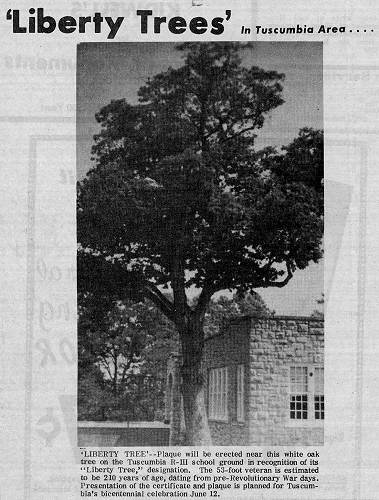
20 Liberty Tree at School - 1976
Click image for larger view
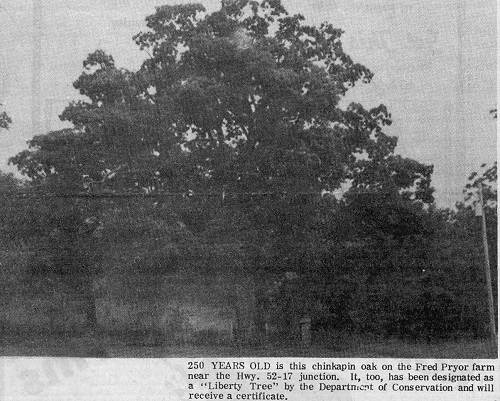
21 Liberty Tree at Pryor Farm - 1976
Click image for larger view
So I drove over to the grade school and found the tree still standing (photo 22).
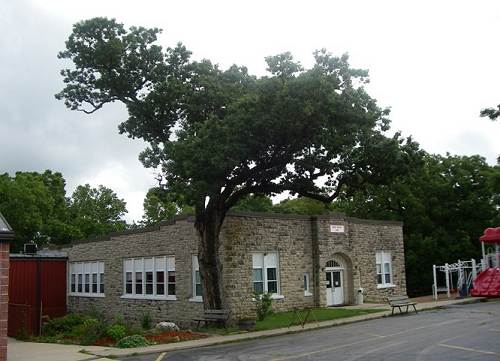
22 Liberty Tree at School - 2008
I remember the tree well from my time as a grade school student there. It appears to be slightly larger than before although not a lot.
Then I went down the hill to the Pryor farm to take a photo of the other Liberty tree, a Chinquapin species, which is located in some woods just behind the home where Jim Pryor now is living (photo 23).
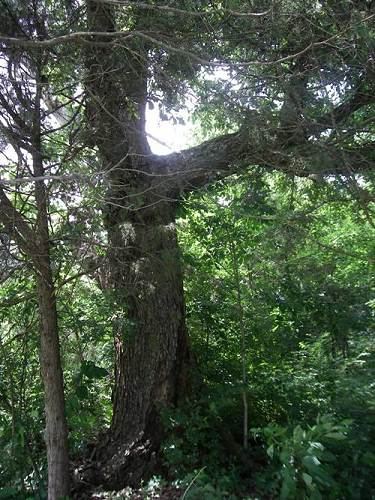
23 Liberty Tree at Pryor Farm - 2008
When I was growing up, I spent a lot of time around this area also since my dad owned the farm at that time, but I never recognized the significance of this tree regarding its age.
I wondered if other Liberty trees were recognized in our county during the bicentennial celebration in 1976. I contacted the Eldon Chamber of Commerce but no record of such recognition was recorded there. If anyone knows about other Liberty trees in the area let me know.
That's all for this week.
|



